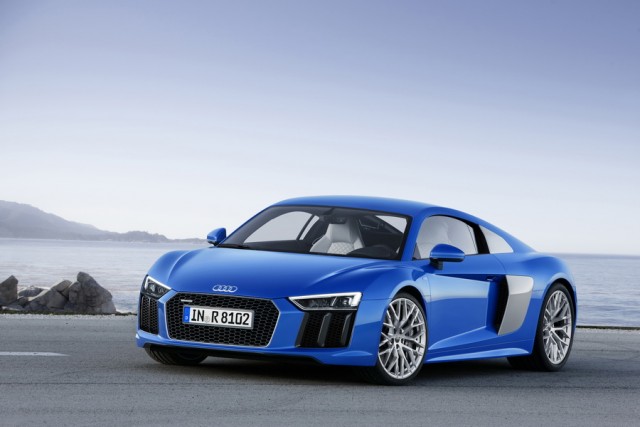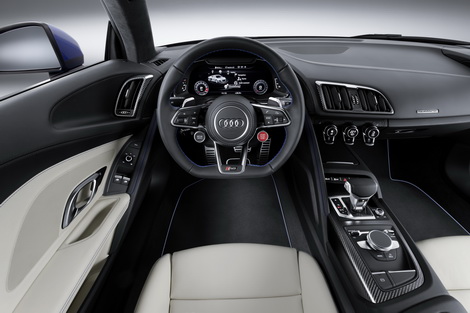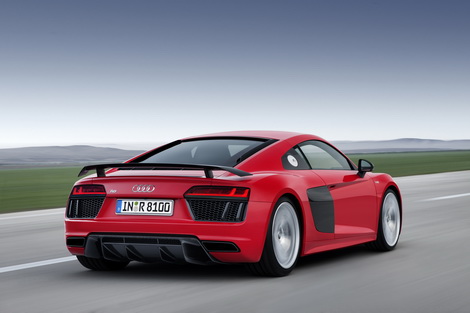Not wanting to be left out following a glut of supercars from the likes of Aston Martin, McLaren and Ferrari unveiled in recent days, Audi has officially taken the covers off its new R8. Now into its second generation, the R8 builds on a solid foundation and showcases a new all-wheel drive quattro system along with a naturally-aspirated V10 engine that will come in two guises.
Exterior
The styling of the new Audi R8 is more evolution than revolution, with a sharper, more angular front grille again dominating the front-end. This is flanked on either side by larger intakes to aid cooling and is crowned on top by more dynamically styled LED headlight units. More deeply sculpted intakes along the car's side help to feed that mighty mid-mounted V10 engine. Only a portion of the original contrasting blade design that ran vertically down the side of the first R8 remains behind the door and appearing again over the rear quarter window.
A flatter, more sculpted rear-end design still carries many of the known R8 design cues. Like on the front, the rear lights are integrated to form part of the rear cooling vents, both of which are pushed to the extremities of the car to enhance the R8's overall width and stance. Two rectangular exhausts brace the car's extreme rear diffuser, which is designed to help improve underbody airflow and add further levels of rear grip.
Interior
Like the interior design seen in the new Audi TT, the new R8 has a very driver-centric layout that features a new flat-bottomed multifunction steering wheel and high-definition TFT virtual cockpit. In a hat-tip to its motorsport achievements, the steering wheel now features even more controls, including the engine start button.
Mechanicals
At the core of the new R8 is a lightweight construction, which, despite carrying more equipment than its predecessor, is lighter by close to 50kg with a total kerb weight of 1,454kg in the case of the R8 V10 plus. Furthermore, a combination of lightweight aluminum and carbon fibre reinforced plastics (CFRP) in the R8's space frame design contribute to enhanced driving dynamics by way of increased torsional rigidity, which at the same time improves safety.
Two power outputs will be offered in the 5.2-litre V10, which is mid-mounted in the R8. In its standard guise it will produce 540hp and deliver a top speed of 323km/h and a 0-100km/h time of 3.5 seconds. A more powerful model, called the R8 V10 plus, will see power output increase to 610hp and will be capable of propelling the supercar to 100km/h from rest in just 3.2 seconds and onto a top speed of 330km/h. Both engines will be mated to a seven-speed S Tronic transmission that sends power to all four wheels via a newly developed quattro system. In more extreme driving conditions, 100 per cent of the torque can be sent to either the front or rear axles. The R8 will also feature the Audi Drive Select system that enables drivers to choose different driving modes to best suit conditions.
The ten-cylinder engine will also feature a new form of Audi's cylinder-on-demand (COD) technology, further improving fuel economy. When less power is required from the engine, it can shut off one of the two cylinder banks by deactivating injection and ignition. As soon as more performance is needed these cylinders fire back into action in a near-seamless fashion. This fuel-saving technology helps the new R8 to achieve a combined fuel consumption figure of 11.8 litres/100km with CO2 output of 275g/km. The same technology in the R8 V10 plus results in a consumption of 12.4 litres/100km and emissions of 289g/km.
Anything else?
Audi will also be premiering its new laser beam headlight as an option in the new R8. The system, which is similar to that seen in the BMW i8, uses a blue laser module that passes through a phosphor element to convert it to white light. By using a laser beam, rather than conventional hi-powered LED high beam, it can illuminate significantly greater distances ahead, but can only be operated at speeds above 60km/h in order to prevent thermal build-up inside the unit.



